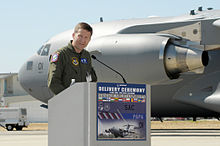- NATO Strategic Airlift Capability
-
The Strategic Airlift Capability (SAC) is a consortium of 12 nations, 10 of which are member states of NATO and two of which are Partners For Peace, to pool together resources to purchase and operate Boeing C-17 Globemaster III aircraft for joint strategic airlift purposes.
The SAC concept was originally intended to be operated in a fashion similar to NATO's E-3 AWACS aircraft program, but is independent of NATO command. Unlike the NATO AWACS program, SAC does not require the unanimous agreement among its partners for operations. Flight hours and mission assignments are determined by a steering committee chaired by a general officer of the United States Air Force.
The operational organization of SAC is the Heavy Airlift Wing, a multi-national force based in Hungary and commanded by a colonel of a member nation. Nearly all operational aircraft maintenance is provided by a 50-man contractor team provided by Boeing. Each SAC nation jointly owns a share of the SAC aircraft, currently three in number, and acquires total annual flight hours according to its own contribution share that it may use at its own national discretion.
Contents
History
The Strategic Airlift Capability (SAC) concept originated at NATO HQ in mid-2006. NATO officials and national representatives envisaged a partnered solution that would satisfy a need for strategic airlift for member states without the economic resources to field a permanent capability. Originally this idea was called the NATO Strategic Airlift Capability (NSAC). In October 2006 the first non-NATO nation joined the initiative and the concept changed its name to the SAC and moved outside the Alliance.
Membership
Member states are NATO members Bulgaria, Estonia, Hungary, Lithuania, the Netherlands, Norway, Poland, Romania, Slovenia, and the United States of America, and Partnership for Peace countries Finland and Sweden. The SAC's initial participants also included the Czech Republic, Denmark, Italy, and Latvia, which withdrew after Hungary, Finland, Norway and Sweden signed the Letter of Intent. On 23 September 2008 the Memorandum Of Understanding MOU came into effect.
The MOU regulates the participation of the two Partnership for Peace (PfP) nations in NATO Airlift Management Organisation (NAMO) and formally established the SAC program to acquire, manage and support three C-17 Globemaster III airlifters. The MOU also directs the formation of the Heavy Airlift Wing (HAW) to operate the aircraft from Papa Air Base in central Hungary, and provides for the other assets needed to meet national requirements of the SAC member countries. NAMO's executing agency for the MOU is the NATO Airlift Management Agency (NAMA). The NAMA was activated in October 2008 and immediately began the process of supporting HAW's activation of Papa AB, and acquiring the C-17 aircraft and their support from the USA under Foreign Military Sales (FMS) program of the US Air Force.
Operations
The first aircraft was delivered on 14 July 2009.[1]. The C-17 Globemasters are based at Pápa Air Force Base in Hungary.[2]
A unique feature of the SAC program is its aviation safety certification system. This system called the Concept of Total Aviation Safety (CONTAS) is based upon a heavily adapted version of the US Air Force's C-17 safety system, the principles of design and operation of heavy airlift aircraft as described by the European Aviation Safety Agency (EASA), and the mandatory requirements of the Hungarian National Transport Authority who are the national authority that registers the aircraft and certifies the operations of the HAW, and the support provided by NAMA. This system has been accepted by all the SAC nations and as such is one of the World's first true multi-national military aviation safety systems.
SALIS
The Strategic Airlift Interim Solution (SALIS) is a similar agreement between 15 NATO participants (Canada, the Czech Republic, Denmark, France, Germany, Hungary, Luxembourg, the Netherlands, Norway, Poland, Portugal, Slovakia, Slovenia, Spain, Sweden and Turkey). The program leases a number of Antonov An-124 aircraft permanently for NATO missions which might occur. The aircraft are contracted from the Volga-Dnepr heavylift company and from Antonov Airlines.[3]
References
- ^ Boeing Delivers 12-Nation Strategic Airlift Capability’s 1st C-17 Globemaster III
- ^ "Military Aircraft Serial Review", On Dutch Wings, Military Aircraft Serial Review, 2008.
- ^ Strategic Airlift Interim Solution (SALIS)
- Jane's Defence Weekly, 27 June 2007
External links
- NATO Strategic Airlift Capability
- Background — Airlifters — NATO’s SALIS Contract (Simon Fraser University)
- NATO Airlift Management Agency
Lists relating to aviation General Aircraft (manufacturers) · Aircraft engines (manufacturers) · Airlines (defunct) · Airports · Civil authorities · Museums · Registration prefixes · Rotorcraft (manufacturers) · TimelineMilitary Accidents/incidents Records Categories:
Wikimedia Foundation. 2010.

